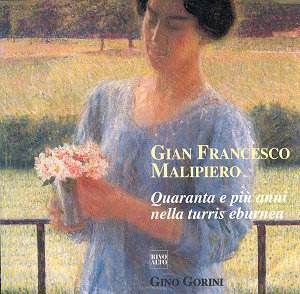First of all I must I must grouse once again (as in
the case of so many of these small independent labels) about the disconcerting
lack of information. This important release has only a scant four-page
booklet in Italian and English. There are no biographical details and
no translations of the names of the works (although in most cases a
little intelligent guesswork suffices). The recording (hardly historical
as the album would suggest) was made in 1968, five years after the death
of Malipiero, by Gorini who one supposes is/was (?) an authoritative
interpreter of the composer’s works. Certainly these readings are impressively
poetic and refined.
The works span the years 1916 to 1959 and the music
often juxtaposes impressionism and expressionism. Much is lyrical, colours
muted and pastel, melodies subtle, understated. The opening La notte
dei morti is rooted in 19th century melancholic Late
Romanticism but with a Debussy-like veneer. Barlumi begins with
the fluidity and sparkle of fountain waters and an occidental twist
that takes the music meandering into reflection and introspection before
more extrovert, playful Debussy-like material leads the music into darker,
rueful territories – an intriguing work of contrasting moods to send
listeners’ imagination flying. The substantial Three Preludes and Fugue
of 1926 (12 minutes) follows very similar moods and patterns; the fugue
adroitly mixing classical formality with an impressionistic delicacy.
Risonanze (1918) has the self explanatory markings:
calmo – fluido – non troppo mosso - agitato non troppo. Again
this is beautifully wrought, rippling, impressionistic music with darker
end pages as the ripples rise to ‘rock the boat’. Hortus conclusus,
from 1946, rocks the boat even more; this is sterner stuff, more elaborate
more searching, more dissonant. The concluding Five Studies composed
in 1959 carry this astringency forward but the music always holds the
ear.
An excellent album of imaginative piano music marred
by inadequate documentation.
Ian Lace


